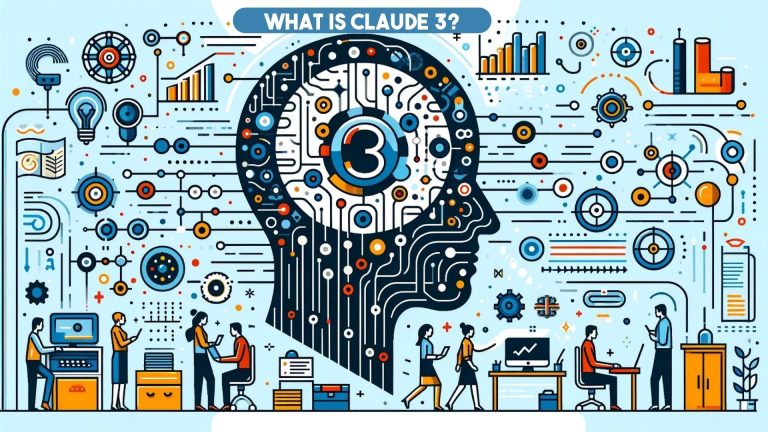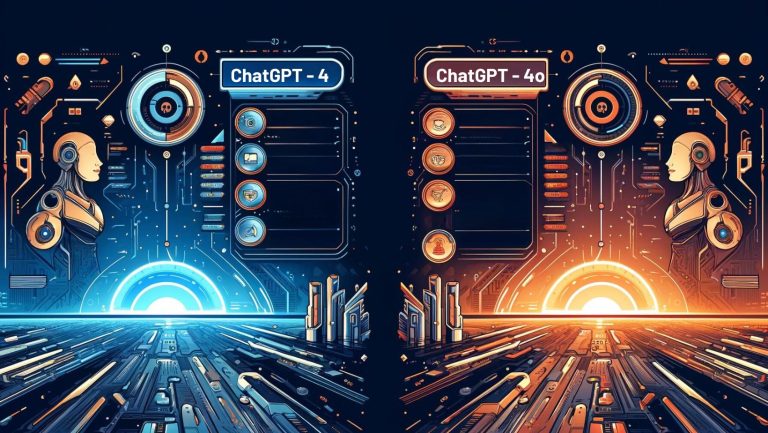ChatGPT 4 Turbo vs Gemini vs Claude 2.1 vs Grok: Revolutionizing AI Technology – Who Leads the Race?
The artificial intelligence (AI) landscape has exploded with innovation over the past year. Powerful new generative AI models like ChatGPT, DALL-E, and Stable Diffusion have captured the public’s imagination with their ability to produce remarkably human-like text, images, and more. However, the pace of progress has been blistering – with tech giants locked in an intense race to develop ever-more capable AI systems.
In late 2022, OpenAI unveiled GPT-4, their largest language model yet with performance improvements over GPT-3. Shortly after came Claude 2.0 from startup Anthropic. And, at the end of 2023, upgraded versions GPT-4 Turbo and Claude 2.1 emerged, alongside Google’s formidable new entry Gemini. Not to mention Elon Musk’s mysterious Grok chatbot.
With so many groundbreaking AI releases in quick succession from leading companies like Google, Microsoft, Amazon and more – how do these new flagship models compare? Which system demonstrates the most advanced natural language generation and comprehension capabilities? And what are their unique strengths that make them suited to particular applications?
This in-depth feature analysis examines the origins and core competencies of four state-of-the-art AI: ChatGPT 4 Turbo, Gemini, Claude 2.1, and Grok. Discover how they measure up to one another in areas like language mastery, reasoning ability, knowledge depth, efficiency, creativity, and more. Gain insight into their target users, ideal use cases, and potential limitations.
Whether you’re an AI enthusiast eager to test the latest systems or a business leader exploring how to leverage these tools, read on for the definitive guide to navigating the new landscape of artificial intelligence in 2023 and beyond.

Key Takeaways: Navigating the New AI Landscape
- No one model rules all tasks – each has distinct design advantages that make it uniquely suited to particular applications.
- Between GPT-4 Turbo, Gemini, Claude 2.1 and Grok – state-of-the-art natural language and multimodal capabilities are emerging.
- With specialties like reasoning, efficiency, creativity, or provocation – there are niche areas where one model clearly outperforms others.
- Understanding model limitations remains critical despite exponential progress – safety, security, and oversight help guide appropriate usage.
- Pay attention to discovery velocity in Large Language Models – today’s top system is tomorrow’s commonplace tool.
- Considering the vast compute resources tech titans invest – keep sight of what truly serves users beyond benchmark results.
- Appreciate this watershed moment while constructively shaping its trajectory – technological shifts oft outpace moral maturity.
The Contenders: Inside the Top AI Models
ChatGPT 4 Turbo – More Affordable Creative Power
As a turbocharged upgrade to OpenAI’s widely-used GPT-4 system for natural language generation, ChatGPT 4 Turbo brings noteworthy improvements:
- 128k context window – Nearly 4X larger than GPT-4 for parsing more information
- Cheaper pricing – $0.01 per 1,000 tokens, making state-of-the-art AI more accessible
- Multimodal capabilities – Combined text, image, audio, video, and other formats
- Up-to-date knowledge – Trained on data up to April 2023
With an expanded context span to draw on, plus integrated multimedia features through OpenAI’s Assistants API, ChatGPT 4 Turbo has exceptional creative potential – able to craft stories, jokes, music, and more with increased coherence.
The launch of this turbocharged model also makes advanced AI significantly more affordable for developers via API access. And, ChatGPT users with a Plus subscription can utilize GPT-4 Turbo directly in conversational chatbot format.
Table 1: AI Model Benchmark Performance
| Model | Context Window | Surpasses GPT-4 Benchmarks | Multimodal Strength | Date Trained Up To |
| ChatGPT 4 Turbo | 128k tokens | No | Yes (text/image/audio/video) | April 2023 |
| Gemini | 32k tokens | Yes (30 out of 32) | Yes (native across modalities) | Not Specified |
| Claude 2.1 | 200k tokens | No | No (text only) | Early 2023 |
| Grok | Not Specified | Not Compared | No (text + live Twitter) | Real-time |
Gemini – Google’s Fearsome First Foray
Heralded as the beginning of Google’s “Gemini era”, this formidable system from Google and its subsidiary DeepMind represents their first model to definitively beat industry leader GPT-4 across benchmarks:
- Surpasses GPT-4 on 30 out of 32 key AI tests like reasoning and language mastery
- Natively multimodal – Handles seamless fusion of text, images, audio, and video natively
- Efficiency-focused – Designed to balance advanced capabilities with practicality
- Phased rollout – Initial Nano and Pro versions enhancing products like Google’s AI chatbot Bard, with Ultra coming in 2024
Gemini’s biggest edge lies in its tight integration of multiple data modalities like text, images, math notation, and more – enabling more human-like comprehension. This foundation better equips the model to excel at complex evaluative tasks requiring cross-referencing of concepts across modalities.
And while the monumental Gemini Ultra model is still undergoing testing, scaled-down versions like Gemini Pro are already demonstrating expansive knowledge and strong language skills augmenting Google’s existing offerings.
With its competitive benchmark performance and multimodal design, Gemini makes a commanding entrance to potentially rival OpenAI’s capabilities.
Claude 2.1 – Specialized for Extensive Text
While less mainstream than rivals from Google and OpenAI, startup Anthropic’s Claude 2.1 model sports an industry-leading 200k token context window – a span nearly 2X as large as GPT-4 Turbo. This grants Claude exceptional facilities for ingesting and analyzing lengthy text:
- Up to 150k+ words – Enables parsing technical papers, literature, and legal docs
- Reduced hallucination rate – 50% lower false claim levels as per Anthropic
- Reasoning specialty – Accuracy benefitting from immense context base
- Early 2023 knowledge cut-off
With its vast context capacity, Claude 2.1 shines for applications like search, semantic analysis, and inference – where both comprehending and correlating concepts across a breadth of text is key. This extensive text processing strength makes it popular for research and other settings with complex analysis needs.
While less flashy than creative juggernauts like GPT-4 Turbo, Claude’s more grounded approach also lends well to use cases where reliability and transparency are paramount. With its large contextual scope and responsible AI design, it is gaining traction in legal, academic, and enterprise deployments.
Grok – X + Humor Goes a Long Way
The mysterious newcomer in this showdown, details remain scarce on exactly what Elon Musk’s novo AI project Grok entails under the hood. But even in its initial testing phase, Grok hints at some compelling traits:
- Information from Twitter via Musk’s platform X grants real-time awareness
- Wit and unconventionality – Distinct personality geared for candidness
- Beta accessibility for X Premium+ subscribers
While Musk boasts Grok’s capacities rival the venerable GPT-3.5 level, Grok’s most provocative quality is undoubtedly its irreverent behavioral slant – promising to handle controversial subject matter without inhibition. Its ties to X also grant access to up-to-the-minute data for increased relevance.
Grok’s aspirations to be an industry provocateur probing boundaries of responsible AI already garner strong opinions on both sides. But its injection of humor and access to live social data give Grok a wildcard factor that makes its further evolution one to watch.
Table 2: Model Specialties and Best Fit Use Cases
| Model | Specialties | Ideal Use Cases |
| ChatGPT 4 Turbo | Creativity, multimedia applications, natural language | Content creation, media production, conversation agents |
| Gemini | Comprehension, reasoning with cross-modal insights | Decision support systems, search, visualization |
| Claude 2.1 | Textual reasoning, semantic search, risk assessment | Research, legal services, finance |
| Grok | Provocation, humor, real-time trend analysis | PR, advertising, prediction tasks |

Evaluating Capabilities: How They Measure Up
Now that we’ve surveyed the key capabilities of each system, how do they practically compare for users in areas like:
Knowledge and Comprehension
- With foundations in web-scale data, all models manifest expansive comprehension – although Claude 2.1 has an edge in ingesting longer texts
- Grok showcases promising awareness of very current information via Twitter integration
- For the fusion of knowledge across text, images, video, and other modalities – Gemini and GPT-4 Turbo have intrinsic strengths
Language and Communication Ability
- Gemini scores best on formal language benchmarks, with experts likening its mastery closer to human level
- All models exhibit advanced writing, grammar, conversational, and linguistic capabilities – with Claude’s reliability a plus
- Grok prioritizes personality and humor over perfect grammar
Reasoning Power and Judgment
- Claude 2.1 solves problems logically thanks to the immense textual context at its disposal
- Gemini likewise demonstrates skilled critical thinking and evaluation to ace specialized tests
- GPT-4 Turbo has enhanced causal understanding and common sense vs predecessors
- Grok remains less geared for raw reasoning than humor and provocation
Creativity and Innovation
- For creative applications like ideation, writing stories or jokes, musical composition and more – GPT-4 Turbo has the edge
- Gemini is notable for imaginative cross-reference between modalities
- Claude 2.1 focuses less on unprecedented creativity and more on sound judgment
- wildcard Grok could prove uniquely creative given its irreverent openness
Speed and Computational Efficiency
- Gemini optimized for practical applications balancing capability with latency/cost
- Leaner Claude 2.1 efficient for extensive text use cases
- GPT-4 Turbo generation is more costly than Claude but faster than the previous GPT-4
- As a prototype, Grok’s computational needs remain unoptimized
Safety and Responsibility
- Anthropic instills focus values like transparency, while both boast stability
- OpenAI and Google detail ongoing research to bolster model integrity
- Wildcard Grok is geared more toward envelope-pushing than precaution
Customization and Control
- OpenAI allows user self-building of personalized GPT models
- Anthropic supports external customization like YouAi’s MindStudio
- Google and X focused less on user model adjustments
While all models have downsides whether incompleteness of capabilities or potential for harm, on the whole each system demonstrates specialized strengths suitable for distinct applications.
Best-Fit Use Cases: Who Should Use What and Why
Based on their advanced competencies and limitations covered above, below is an overview of suitable real-world applications for each AI:
ChatGPT 4 Turbo
- Innovation – New product/service ideation, campaign creation
- Engaging Content – Viral marketing copy, stories, and humor that captivate audiences
- Conversation – Nuanced chatbot customer service engagements
- Creativity – Music, games, generative art, and similar dynamic media
- Multimodal – Fusing content types like text, images, audio intuitively
Gemini
- Comprehension – Understanding complex interdisciplinary concepts
- Evaluation – Assessing ideas weighing multiple angles and data formats
- Search – Processing extensive sources to synthesize understanding
- Reasoning – Logical problem-solving with cross-disciplinary insight
- Decision Support – Evidence-based guidance factoring varied inputs
Claude 2.1
- Text Analysis – Parsing intricate technical papers, financial reports, legal documents
- Semantic Search – Structured querying of extensive corpora based on contextual meaning
- Risk Assessment – Judging liability issues backed by broad evidence trails
- Compliance – Ensuring protocols and processes heed regulations
- Research – Rapidly analyzing papers to accelerate discovery
Grok
- Trend Analysis – Tapping real-time signals from X to reveal emerging patterns
- Consumer Insight – Candid pulse-taking from users willing to share openly
- Fun & Games – Viral entertainment content with a dose of humanity
- Unfiltered Conversation – Relatable chat without inhibitions
- PR & Advertising – Attention-grabbing messaging with wit and edge
While some overlap exists, each AI has sweet spots where its design empowers it to unlock unique value.
Table 3: AI Model Development Companies
| Model | Parent Company | Year Founded | Headquarters Location |
| ChatGPT 4 Turbo | OpenAI | 2015 | San Francisco, USA |
| Gemini | Google DeepMind | 2010 | London, UK |
| Claude 2.1 | Anthropic | 2021 | San Francisco, USA |
| Grok | xAI | 2023 | Unknown |

The Outlook: What’s Next in AI
With Large Language Models advancing so rapidly, today’s state-of-the-art looks humble in 6 months time. Where might contenders like GPT-4 Turbo, Gemini, Claude, and Grok progress as 2024 unfolds?
- More nimble OpenAI will likely stay at the forefront of consumer AI
- Google DeepMind targeting advanced reasoning for multifaceted analysis
- Anthropic positioning Claude as a compliant enterprise solution
- Grok is set to gain sophistication once beyond the limited beta
And across categories like:
- Integrations – Microsoft seamlessly blends Copilot AI into offerings
- Multimodality – Fusing more senses like speech, touch, and movement
- Reasoning – Less correlation, more causation, and planning ability
- Specialization – Models finely tuned for niche applications
Standing on the shoulders of systems like GPT-3, BERT and more – today’s foundation models enable abundantly capacious comprehension and communication. DALL-E 3 and AlphaFold created images and proteins unattainable before.
Yet for artificial general intelligence (AGI) matching multifaceted human cognition across disciplines, clearly massive headroom remains. With AI barely toddling towards autonomy, explainability, and responsibility – startups to tech titans will surely further this frontier.
While narrow AI propels industries today, broad AGI may profoundly reshape society tomorrow. So stay apprised of progress from key innovators like OpenAI, DeepMind, Anthropic, and new entrants in this epoch of historic advancement. Even seemingly incremental improvements may one day unravel guardrails fundamental to human identity and purpose.

Final Thoughts
The race for AI supremacy grows more electrifying by the day. With tech titans unleashing ever-larger language models at a blistering pace, it’s hard to predict who will dominate even 12 months from now.
Yet what truly matters isn’t abstract benchmark rankings, but how these tools better lives. While arms races make headlines, end users crave comprehension, judgment, and creativity that augments their abilities.
So the winners will be those who make AI less inscrutable, more accessible, and focused squarely on empowering people’s potential. Systems designed for good that responsibly avoid pitfalls of polarization and manipulation.
The next epochal advancement may emerge from an unexpected underdog, rather than trillion-dollar behemoths fixated on beating one other. For AI to enable human flourishing, we must guide its growth wisely. What unfolds in 2024 and beyond hinges on collective choices – not computational might alone.
Frequently Asked Questions Related to ChatGPT 4 Turbo vs Gemini vs Claude 2.1 vs Grok

Cal Hewitt is the Founder, CEO, and Project Lead at Web Leveling, a digital marketing agency empowering small and mid-sized businesses to thrive online. With over 27 years of experience in business analysis, management, consulting, and digital marketing, Cal brings a unique perspective to every project. He specializes in website design and development, AI consulting, social media marketing, and online reputation management. Cal’s hands-on leadership style and commitment to innovation ensure that Web Leveling stays at the forefront of digital marketing trends, delivering transformative results for clients.








